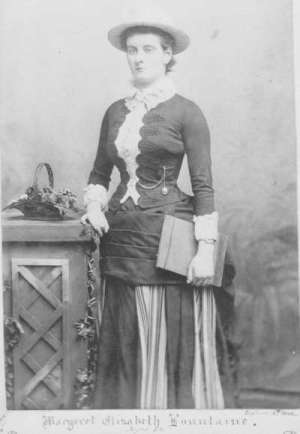Colleen Mondor's Blog, page 29
June 1, 2012
"Butterflies were Margaret's key to freedom."
I am reading Wild & Fearless: The Life of Margaret Fontaine by Natascha Scott-Stokes. To say that I am in love with this woman, a late 19th/early 20th century naturalist (butterfly collector), would be a vast understatement. I'll write more when I'm done but if you have an interest in lady explorers then you need to snap this one up.
[Post pic via the Norwich Museum which holds Margaret's butterfly collection. Post title from Wild & Fearless.]

May 31, 2012
"...Wegener replied, Why should we hesitate to toss the old views overboard?"
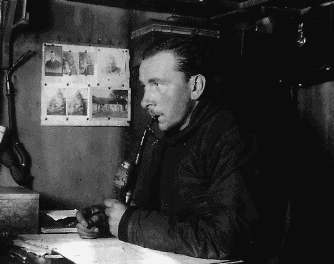
From Smithsonian, Alfred Wegener and the theory of Continental Drift:
We like to imagine that knowledge advances fact upon dispassionate fact to reveal precise and irrefutable truths. But there is hardly a better example of just how messy and emotional science can be than Wegener's discovery of the vast, turbulent forces moving within the earth's crust. As often happens when confronted with difficult new ideas, the establishment joined ranks and tore holes in his theories, mocked his evidence and maligned his character. It might have been the end of a lesser man, but as with the vicious battles over topics ranging from Darwinian evolution to climate change, the conflict ultimately worked to the benefit of scientific truth.
Wegener's story is horribly forgotten but shouldn't be. He's a amazing man (he came up with the idea of the "supercontinent" and gave it the name Pangea) and a true scientific hero. (If you're interested in a book about him, I reviewed Ending in Ice for Booklist several years ago and can recommend that one!) (But be aware, Wegener is yet another tragic polar story - although his death seems quite fitting almost in light of his lifelong research.)
[Post pic via UC Berkeley, title from Smithsonian Mag.]

May 28, 2012
On bloggers & authors
1. Authors need bloggers more than bloggers need authors.
2. Seriously.
3. The thing is, a lit blog can be interesting and appealing without ever running a single author interview. You do not need to blog about the latest releases or trends to maintain a decent readership. Authors on the other hand need bloggers to help spread the word on their books and the sooner after publication (or even before), the better.
4. As someone who had a book published six months ago I am abundantly aware of just how important blog mentions can be - and how much publishers really, really, REALLY want authors to obtain blogger attention.
5. And as a longtime online reviewer (both here and as the Bookslut YA columnist) I know how hard authors work at getting that attention.
6. Here's a tip - emails addressed "Dear Blogger" are not a good use of your time. Ever.
7. The author side of me would like to be able to send out a hundred emails to a hundred bloggers and receive immediate positive replies promising reviews, interviews and blog mentions.
8. The blogger side of me wishes authors would never contact me and instead wait patiently until I sent them emails requesting information or interviews and then responded promptly with exactly what I've asked for.
9. To say I'm conflicted on this subject would be an understatement.
10. Surprisingly, the answer to how blogger and authors can most effectively work together is actually pretty simple. You have to be willing to put in the time. Bloggers have to be willing to write consistently smart and entertaining posts and authors have to be willing to engage with lit bloggers on subjects other than their own books. Through time bloggers will make themselves someone who authors want to engage with and vice versa. Conversations will take place that have nothing to do with the author's book or the blogger's blog but books and blogs and all manner of literary greatness in general.
11. Many good things happen at this point.
12. Of course you can certainly circumvent all this time and work. As a blogger you can conduct giveaways, lots and lots of giveaways, and you can drive up traffic to your blog by being the place that gives away free stuff and authors will want to take advantage of those numbers and likely ask you for the chance to guest post or interview and it will seem like a good idea to do this but authors need to keep in mind that readers who are looking for free books don't generally translate into sales (which is what authors need) and bloggers who run endless giveaways need to realize that this is a lot of work.
13. But hey, if being the book world's version of Wrap-N-Pack is your idea of having a literary conversation then go for it.
14. For authors this is all a lot trickier then you might have hoped or planned for. Again, we are the ones who need that blogger attention and must deal with publishers advising us to court it while never explaining how. The notion that authors must start investing time in the lit blogosphere years before publication might seem crazy and, quite frankly, a hella lot of work with no promises of a return.
15. (It's sort of like writing that way.)
16. But that's what you have to do. Bloggers (most of them anyway) are blogging about books because they love them and they want to share their thoughts with other book lovers. Authors are writing books because they have stories to tell that they want to share with the world. Engaging in online conversations (via comments and tweets) is the best way for us all to geek out in the most wonderful bookish way. Authors should approach blogs from the point of fun, read blogs they like and comment on posts they enjoy. This isn't hard (it's fun!) and over time you get to know the bloggers, the bloggers get to know you, and thus when you have a book come out there are already some folks cheering online in your corner.
17. As this is what happened to me, I'm sure it is what will happen to you.
18. The main thing authors need to understand is that bloggers receive emails all the time from authors they do not know asking them to read books they have never heard of. Whatever you plan to send, trust me when I say I've heard it before. The odds are slim to none that your email will stand out or that a blogger will even take the time to read it.
19. The main thing bloggers need to understand is that authors are under a tremendous amount of pressure to engage with online communities and create buzz via social media and use the internet as a platform to increase their book sales. (Did all of that sound dreadfully spinny? It should, but it's all true. Horribly, sadly, depressingly true.) They are sending out those emails in desperation because at least then they can feel like they tried and more importantly they can tell their publisher they did something.
20. The bottom line is that, well, it can't just be about you. No relationship works that way and when we take a step back and think about it, everybody knows this.
21. Except maybe publishers. Sigh.

May 24, 2012
Catalogging Abrams Books
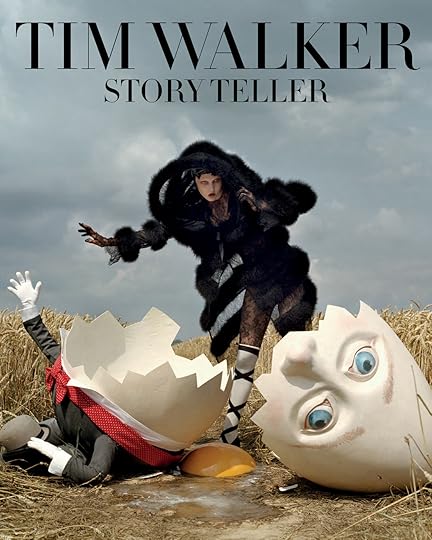
Is there any book catalog more beautiful than Abrams Books? I'm going to go out on a limb here and say "no". While I love Princeton Architectural Press and there are many lovely things about Chronicle and Candlewick, page by page I have to say that Abrams wins this one hands down. It's not just the covers but the excerpts and not just the excerpts but the overall design - heck even the paper is scrumptious.
I am looking at the fall 2012 catalog right now, can't you tell?
A lot of these books jumped out me, some as excellent titles to review in my column, some as personally appealing and some as titles that I know other folks will adore. First up, there's a new book on designer Alexander McQueen by photographer Anne Deniau who was the only photographer allowed backstage at his shows for thirteen years (ending with his death). Love Looks Not With the Eyes celebrates the creativity of both of them - both in what he made and how she saw it. Beautiful.
Nick Brandt's African wildlife titles On This Earth and A Shadow Falls are now combined in a doortstop edition that is oversized enough to do them justice. Essays from Jane Goodall, Alice Sebold, Peter Singer, etc. Love his work (but be prepared to pay for it). Another animal title is due from Tim Flach - More Than Human. This is one of those you just need to see to believe. It is "a highly original visual and written enquiry into our relationship with animals..." The cover alone is like few others. (Panda!!!!!)
Whatever Happened to the World of Tomorrow by Bryan Fies is coming out in pb with a new rocket-shippy cover. I have this in HC and it's a great gn. Very funny and totally plays on so many things like THE FLYING CARS WE WERE PROMISED!!! (I'm still bitter about that.) Also, there's Economix: How and Why Our Economy Works (and Doesn't Work) in Words and Pictures by Michael Goodwin. This looks perfect for teens (and a lot of adults). I'm also excited to see The Carter Family by Frank Young and David Lasky. Talk about an unorthodox family to get the bio treatment in a gn! And it comes with a cd! Excellent American history and in a format that will get it a lot of teen attention (I hope). (Geeky music teen attention, I'm sure.)
There's a new Vogue book - The Editor's Eye. It's all very very pretty. Tim Walker (who has been in Vogue a very memorable time or two) also has a new book out - Storyteller which "showcases his signature fantastic style". The cover alone makes it impossible to resist. (Though yes, very pricey.) (I'm still putting it in on my holiday wishlist though.) A fashion memoir that I thought had teen appeal is I Want To Be Her! by Andrea Linnett. Illustrated with the most charming sketches by Anne Johnston Albert this is Linnett's salute to all the people who have shaped her style over the years. (She's the co-founder of Lucky.)
Oh - and Todd Selby returns with Edible Selby. This go-round he's focusing on chefs with looks at gardens, homes, kitchens and restaurants. It will include the same short interviews as his last book but everyone also contributes a recipe. What I like about Selby is the interesting things he gets people to share about themselves and the places he photographs them. His work is never dull that's for sure.
I mentioned Orhan Pamuk's The Innocence of Objects a few weeks ago and the interior shots make it even more appealing. Filled with photos of his own collections, "...he writes about things that matter deeply to him: the psychology of the collector, the proper role of the museum, the photography of old Instanbul..." and on and on. What is there not to love? Christine Davenne's Cabinets of Wonder seems in the same vein but much broader - unique collections in homes and museums but also the history of such collecting. You've got to see the pictures! Plus I love cabinets of wonder - "skulls, butterflies, hunting trophies, ancient Egyptian artifacts, the alleged skeletons of mythological creatures..." You know you want to read it.
And finally, The Nao of Brown by Glyn Dillon, a gn with a half Japanese, half English heroine suffering from OCD and "fighting violent urges to harm other people". She wants to change her life, she wants to pursue her dreams, she wants to find love. She's 28 but this has coming-of-age written all over it; we'll see if it wanders into crossover territory. Either way - it certainly looks and sounds unique.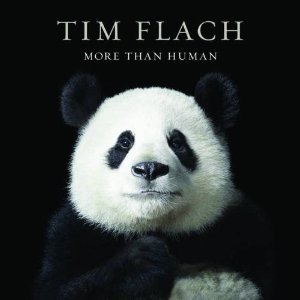

May 23, 2012
Pathways
Jenny Davidson on finding your way as a writer:
I am pretty sure I really am going to stop writing novels, by the way; I don't have the resources of time and attention to do it properly, and it then erodes my pleasure in other things I should be enjoying more, namely my core mission of reading and writing about books and generally living in the world of words and ideas.
And Theodora Goss takes stock:
When you're a writer, the cure for whatever ails you is always writing. (Someone quote me on Goodreads. That's the secret, in good times and bad: keep writing.) To figure out, or remember, who I am as a teacher, a writer, even simply as a person. To act out of that knowledge, rather than out of stress or anxiety.
My writing path is leading me again, surprisingly, to the Last Frontier. I didn't expect this. I watch reality tv and the notion of the Last Frontier is both sad and silly. But then I remember that frontier is what we make it and so I settle down and write again. The other day I found this while looking for the meaning behind the word "frontier". It's a Levis commercial but I love it. And it is exactly what I know frontier to be.

May 22, 2012
On mountains and space and my NPR moment
1. So yesterday was pretty darn huge from a writerly perspective. Nancy Pearl selected MAP as a Summer Read for NPR. This was a total bucket list moment and I can't begin to say what it means.
2. I plan to beam about this moment for a while. Like months. In case you were wondering.
3. I am happy to be reading positive reviews on the upcoming HBO movie about Martha Gellhorn and Ernest Hemingway. If you are a Gellhorn fan (and you should be), you must check out this essay at The Millions on the letters Gellhorn exchanged with the author's grandmother. Great stuff on writing and motherhood and being a mid-century woman with dreams.
4. Neil Gaiman writes about the very romantic origin of one of Amanda Palmer's songs on her upcoming album. He also writes about a very expensive book that is part of her Kickstarter project. Those two really do things first class all the way. (I'm supporting the project by the way - but on the much lower CD level scale.)
5. I'm still freaking out about being on the NPR website.
6. SPACE X has successfully launched!!!
7. If you like zombie stories I highly recommend When Will You Rise by Mira Grant, upcoming from Sub Press. This novella freaked me out in a cold, calculating, completely believable, Stephen-King's-The-Stand kind of way. I don't really like zombie stories but I can't forget what Davis has done here. Check it out.
8. Outside magazine has an impressive piece of journalism up online about the recent deaths on Everest. This picture pretty much says it all, doesn't it? Look at that line up. Remove the snow it might as well be Disney. Crazy.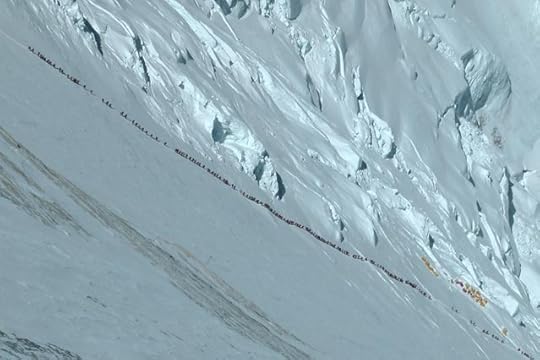
[Post pic by Ralf Dujmovits from Outside.]

May 20, 2012
On why The Book of Blood & Shadow is not The Da Vinci Code for teens
I recently finished, and thoroughly enjoyed, Robin Wasserman's YA thriller The Book of Blood and Shadow. (The formal review will be in my July column.) In surfing through some reviews/comments about the book though I was surprised by how consistently it is referred to as "The Da Vinci Code for teens". While I see the general plot similarities (centuries-old secret found in archives by innocent amateur scholar, dueling secret religious societies have been trying to uncover truth forever, people must run for their lives, etc. etc.), The Book of Blood and Shadow is most certainly not a book about uncovering an ancient religious secret anymore than ET was a movie about aliens. Seeing that difference - and why the difference matters so much to the story - is a big part of why I think Wasserman has really hit one out of the park with her novel.
And yes, it is for teens although adults can enjoy it plenty.
The other night we watched Super 8 (and loved it) and afterwards watched the documentary about making the movie where JJ Abrams discussed working with Steven Spielberg and the similarities between Super 8 and ET. Spielberg has said that ET was first and foremost a movie about divorce and that was something Abrams took to heart. Super 8 is clearly a movie about surviving childhood - about seeing your parents as people, about tragically losing a parent and yet not losing your family and also (like ET) about the friendships that can pull you through the very tough times. There are aliens in both of these movies and they are obviously critical to the plots but the stories are about much more domestic concerns.
The same thing is true of The Book of Blood and Shadow. The thriller aspect is critical to keeping the plot moving and there is all kind of translating old letters and running for your life and getting captured and escaping, and even grisly murder along the way. But at its heart Blood and Shadow is about first love and old friendships and how easily friendships can be abused when you are young. It's about choosing wisely and loving carefully and while some readers might be tempted to say all of those things happen only because of the unfolding conspiracies, all of us who look back on our teen years with a jaundiced eye know that you don't need a secret order of something-something chasing after you to make the 9th grade a living hell. All too often that is just the way it is and navigating successfully through that period goes a long way toward making your adult years happy and healthy.
Wasserman has a lot more going on in her novel - there is a careful look at parents and their failures (all quite common but significant nonetheless) and there is also a bit about teachers and students and unrealistic expectations. But as much as I loved seeing Nora get to the heart of this mystery (and I can't stress how much I loved her as well as the character of Elizabeth whose letters guide her from 400+ years before), it is the coming-of-age story that made The Book of Blood and Shadow stand head and shoulders above so many other titles I've read this year.
The Da Vinci Code was a thriller while what Robin Wasserman has written is a book about growing up. That difference is what makes her book so much better and why I think it will resonate with thoughtful readers of any age.

May 17, 2012
I think I saw this in a Buffy episode
I really liked the idea of The Battle of Blood and Ink, a new graphic novel by Jared Axelrod and Steve Walker (from Tor). In the floating city of Amperstam, everyone reads The Lurker's Guide, a one sheet guide that tells all the news that no one else does and reveals all the city's secrets. Ashe, who manages to be brilliant and glamorous but also poor and gritty, is the woman behind the newspaper. In the opening pages she uncovers a big secret and the government (which is basically a single steely-eyed female dictator person) decides it has to silence her. And then lot of other things are revealed and things all go to hell in a handbasket and Ashe barely survives.
So what's not to love? Well, I'm kinda conflicted actually. On the one hand it is an action-packed novel and Ashe is very unique and she kicks all kind of butt and THE CITY FLIES! But there are some serious plot holes here and I'm having trouble getting past them. Part of my frustration is due to the fact that this is supposed to be a story about a crusading underground journalist but only one issue of the newspaper is released and as soon as Ashe starts to uncover some secrets (other than the first one) she never thinks once about sharing them with the public. She morphs from writer to Avenger in all of six seconds and suddenly your reading a whole different book then you planned.
Second, it's hard to understand how Ashe could be a broke street kid on one hand but highly educated and capable of publishing a newspaper (with her one friend) on the other. No one ever explains this. Also not explained is why she has tattooed arms and why only some people in the city have arms like that and where those tattoos come from (other than to show the class differences). (They end up being a bit plot point which is why I'm bugged by the questions.) The biggest problem is with the biggest secret though. I don't want to spoil anything but I will say that it immediately reminded me of the Season 3 Buffy episode "Anne". That was okay though (just a bit similar) but what wasn't is a completely unexplained plot point that a lot of things hinge on. (As in how did she escape from a place no one else has escaped from and I'm sorry but just forgetting it all until she uncovers it accidentally later is far too convenient a use of amnesia to be believed.)
And how come the dictator has let her run around and be annoying all this time if she really is that powerful and tough?
So yeah, conflicted. The artwork is fine, the characters are interesting but I think story was sacrificed for action on more than one occasion. (Heck, I think some plot was sacrificed for it.) It felt rushed and that's a shame. Ashe is an interesting girl; I would have loved to see her at actual work rather than being a bit of a Buffy wannabe.

May 16, 2012
An Innocent Man
1. A devastating and important account of a definitely innocent man executed in Texas. This is the reason why I struggle with the death penalty - because our justice system just is not good enough to handle it. (I cheered when Ted Bundy was put to death in Florida and I will never doubt that he deserved it but we make too many mistakes to justify those moments.) From The Atlantic:
Reading through the manuscript last weekend, jarred by what I was seeing, I began to jot down a list of things that went terribly wrong in the DeLuna case -- issues of fact, of evidence, of testimony, of motives, of incompetence, of indifference, of fraud, of morality, of integrity, of constitutionality -- that should have been raised and answered long before DeLuna was convicted, much less executed, back in the 1980s. I stopped when I got to 10.
2. Vogue looks at the HBO series on obesity in America:
No matter how expansive the scope, the documentary tugs hardest when showing interviews with those who suffer from obesity, who list their vitals with a crestfallen countenance that never gets easier to watch. "Food can be my best friend," explains a nearly 300-pound 28-year-old named Vivia, as her eyes well. "It can be my boyfriend, at the moment; a trip to the beach."
3. For the 50th anniversary of Silent Spring's publication, David Brinkley writes in Audubon about JFK and Rachel Carson:
When Silent Spring was at last published in book form on September 27, 1962, the chemical industry went ballistic. Kennedy instantly became Public Enemy No. 1 for propping up Silent Spring as worthy of serious attention. The National Agricultural Chemicals Association rushed its propaganda booklet "Fact and Fancy" into print. The nub of the counterattack was that Mr. Fancy (a.k.a. Kennedy) was an East Coast elite who yachted frivolously around Cape Cod, his treasured national seashore, while allowing DDT manufacturers to be unjustly vilified. The association warned that factory shutdowns would mean thousands of lost jobs. When Kennedy awarded Dr. Frances Oldham Kelsey--a Food and Drug Administration scientist--a public service gold medal for discovering that thalidomide (a sedative frequently prescribed to pregnant women) caused deformities in babies, the pharmaceutical industry likewise felt blindsided. "It is all of a piece," Carson told The New York Post, "thalidomide and pesticides--they represent our willingness to rush ahead and use something new without knowing what the results are going to be."
We need another Rachel Carson about climate change, and we need her now.
4. I bought the new issue of Vanity Fair because Marilyn Monroe is on the cover. The story inside portrays her as so smart and yet so frustrated by what she can not control that it made me wince. The pictures are amazing - as they always are of Marilyn. She should have lived; she really deserved so much more than she got. Wasn't she just amazing? Wow.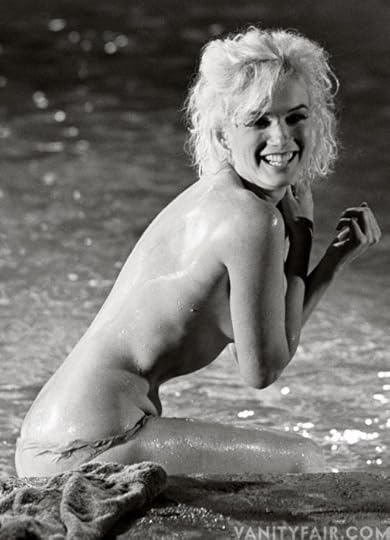

May 14, 2012
Catalogging Chronicle Books
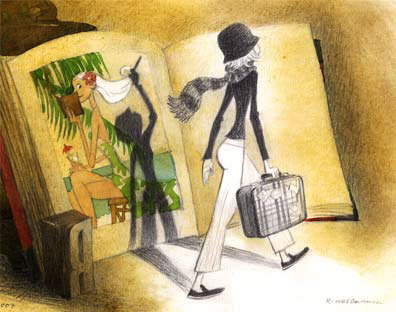
Fall titles from Chronicle that caught my eye:
Sketchtravel by Gerald Guerlais and Daisuke Tsutsumi - Passed between 72 artists over five years and 35,000 miles the sketchbook showcases the creativity of artists of all kinds from around the world. Talk about inspiration - this one should take readers in all sorts of unique directions. (192 full color illustrations throughout)
The Where, the Why and How: 75 Artists Illustrate Wondrous Mysteries of Science by Jenny Volvovsky, Julia Rothman and Matt Lamothe - A collection of essays by scientists and accompanying illustrations by all kinds of artists who interpret those essays in their own way. I have no idea what is inside this book but any original take on science is going to get my attention and I hope it works as a crossover for teens (how could it not?).
Sky High by Germano Zullo, Illustrated by Albertine - A picture book (ages 8 & up) about two competing neighbors who add to their houses in outlandish fashion in a race to see whose home is tallest. It made me laugh and laughing is good.
Unusual Creatures by Michael Hearst - What we have here are life forms that stretch the limits of truth but they are out there (the blobfish!) and page after page you will learn all about them. Plus more awesome illustrations, diagrams, and more. Lemony Snicket wrote the introduction and that, of course, makes me very happy.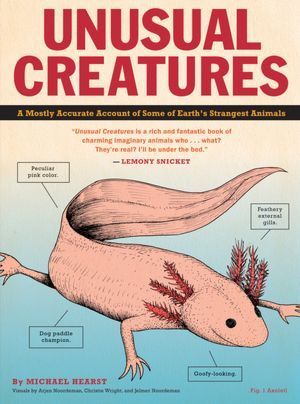
[One of the contributor's shots from Sketchtravel - see more about how this one came to be here.]


